Jim Fouratt | |
|---|---|
| Born | June 23, 1941 |
| Nationality | American |
| Known for | Gay activism |
Jim Fouratt (born June 23, 1941) is a gay-rights activist, actor, and former nightclub impresario. He is best known for his involvement with the Stonewall riots and as co-founder of Danceteria in New York City. [1]
Fouratt was raised in a working class Catholic home in Riverside, Rhode Island. He attended the La Salle Academy in Providence. After high school he was accepted into Harvard University but could not attend for financial reasons, instead he began studies at St. Peter's Seminary in Baltimore. In 1960, he was kicked out for homosexuality and moved to New York City. [2] [3]
Fouratt took up political activism more seriously in 1965, after being arrested in Times Square at America's first Anti-Vietnam war demonstration. In 1967 he was one of the organizers of the famous Central Park Be In. That same year he cofounded the Yippies, a youth-oriented countercultural movement, alongside Abbie Hoffman, Jerry Rubin and Paul Krassner. [1] [4]
Fouratt was at the first night of what he calls the Stonewall 'Rebellion', a term he prefers over "Stonewall Riots." [5]
I happened to be coming home from my job at Columbia Records. I saw a sole police car outside of the Stonewall Inn. I was out in the New Left movement and the anti-war movement and there was an incredible amount of homophobia—in the old and new left. Like a good '60s radical, I went to see why that car was there. There might have been 20 people around—this was 10:30 at night. [6] [7]
On the third night of the rebellion, Fouratt co-founded the Gay Liberation Front, the first of many lesbian and gay liberation movements that sprouted across the country in the following months. [1] [8]
Fouratt was a founding member of the Lesbian and Gay Community Service Center, the Gay Community Service Center, and Wipe Out AIDS (now known as H.E.A.L). [9] He was active in ACT UP, serving on the media committee with Michael Signorile and Jay Blotcher. [3]
In 2009, Fouratt took part in the Democratic primary against City Council Speaker Christine Quinn. He claims to have raised $20,000 in two weeks, but later withdrew. [1] In 2016, Fouratt ran for State Assembly but lost to Deborah Glick. [10] He is a member of the Village Independent Democrats club. [1]
In 1969 Fouratt worked as an assistant to Clive Davis. [3]
In 1978, Fourrat became the manager for the club Hurrah where he brought in DJs to create the first "rock disco," with music videos playing as well as live music acts. [11] He also worked at Pop Front, and Studio 54. [1] [12]
In 1980, he opened the nightclub Danceteria with Rudolf Pieper. In November 1980, Pieper and Fouratt had prepared to open the New Peppermint Lounge night club, but were pushed out by Frank Roccio and Tom Goodkind. [13] In June 1982, Pieper and Fouratt became embroiled in a legal battle, and Fouratt was pushed out. [14]
In the early 1990s, Fouratt served as director of national publicity at Rhino Records, [9] and from 1995 to 1999, Fouratt was the vice president of A&R at Mercury Records. [15] In the late 1990s, Fouratt attempted to launch the sub-imprint Beauty Records, but that project ended when PolyGram, Mercury's parent corporation, was bought by Seagram's, and Fouratt's acts were let go. [16]
Fouratt has been pop culture critic for Billboard and Rolling Stone [1] [17] and a contributing editor at Spin. Additionally, he has written for The Village Voice, [18] TheAdvocate, Bay Area Reporter, Gay City News and Come Out! . [15] [19] He is currently an editor for Westview News. [20]
Fouratt studied for seven years with Lee Strasberg in the early 1960s. Fouratt was a member of the Open Theater, and performed at Café Cino and La MaMa. He joined Actors Equity and made his Broadway debut in The Freaking Out of Stephanie Blake . [12] He worked with the National Shakespeare Theatre in Cambridge. [3]
In 1969, Fouratt asked his lover Peter Hujar to take a photograph for a Gay Liberation Front recruitment poster. The image is now one of the most iconic of the gay liberation movement. [21] [22]
Hujar's boyfriend at the time, Jim Fouratt, arrived on the scene to organize for the Gay Liberation Front (GLF), the first political group to cite homosexuality in its name. Hujar agreed to make a photograph for a GLF poster. The poster, portraying a jubilant group of GLF members under the slogan COME OUT!!, appeared in late spring 1970 in advance of the gay liberation march that marked the first anniversary of Stonewall.
Fouratt has faced criticism for his comments on transgender identities and transsexualism, which he views as a method "to make gay men and lesbians straight." [23] He believes that transgender identity reinforces gender stereotypes [24] and that trans discourse is marginalizing the experiences of gays and lesbians. [25] However, in a 2015 Facebook post, he wrote "I support the right of each person to control their body. Period. Fighting the conscription of socially policed gender behavior is an essential fight." [26]
In 2009, when asked by Stephen Colbert if there was a leader in the gay community on par with Martin Luther King Jr., Fouratt said "Well, I would like to think that I'm that leader." [27]
Fouratt previously lived with Carl Miller, Allen Young, and Giles Kotcher in the Seventeenth Street commune. [28] [29]

Lesbian, gay, bisexual, transgender and queer (LGBTQ) movements are social movements that advocate for LGBTQ people in society. Although there is not a primary or an overarching central organization that represents all LGBTQ people and their interests, numerous LGBTQ rights organizations are active worldwide. The first organization to promote LGBTQ rights was the Scientific-Humanitarian Committee, founded in 1897 in Berlin.
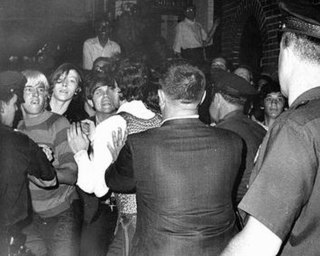
The Stonewall riots were a series of spontaneous riots and demonstrations against a police raid that took place in the early morning hours of June 28, 1969, at the Stonewall Inn, in the Greenwich Village neighborhood of New York City. Although the demonstrations were not the first time American homosexuals fought back against government-sponsored persecution of sexual minorities, the Stonewall riots marked a new beginning for the gay rights movement in the United States and around the world.

Gay Liberation Front (GLF) was the name of several gay liberation groups, the first of which was formed in New York City in 1969, immediately after the Stonewall riots. Similar organizations also formed in the UK, Australia and Canada. The GLF provided a voice for the newly-out and newly radicalized gay community, and a meeting place for a number of activists who would go on to form other groups, such as the Gay Activists Alliance, Gay Youth New York, and Street Transvestite Action Revolutionaries (STAR) in the US. In the UK and Canada, activists also developed a platform for gay liberation and demonstrated for gay rights. Activists from both the US and UK groups would later go on to found or be active in groups including ACT UP, the Lesbian Avengers, Queer Nation, Sisters of Perpetual Indulgence, and Stonewall.

The gay liberation movement was a social and political movement of the late 1960s through the mid-1980s in the Western world, that urged lesbians and gay men to engage in radical direct action, and to counter societal shame with gay pride. In the feminist spirit of the personal being political, the most basic form of activism was an emphasis on coming out to family, friends, and colleagues, and living life as an openly lesbian or gay person.
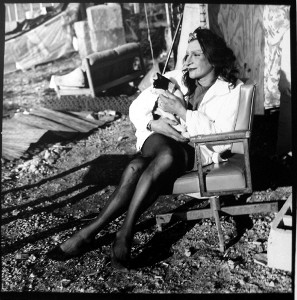
Sylvia Rivera was an American gay liberation and transgender rights activist who was also a noted community worker in New York. Rivera, who identified as a drag queen for most of her life and later as a transgender person, participated in demonstrations with the Gay Liberation Front.
Martin Bauml Duberman is an American historian, biographer, playwright, and gay rights activist. Duberman is Professor of History Emeritus at Lehman College in the Bronx, New York City.

Morris Kight was an American gay rights pioneer and peace activist. He is considered one of the original founders of the gay and lesbian civil rights movement in the United States.

The NYC Pride March is an annual event celebrating the LGBTQ community in New York City. The largest pride parade and the largest pride event in the world, the NYC Pride March attracts tens of thousands of participants and millions of sidewalk spectators each June, and carries spiritual and historical significance for the worldwide LGBTQIA+ community and its advocates. Entertainer Madonna stated in 2024, "Aside from my birthday, New York Pride is the most important day of the year." The route through Lower Manhattan traverses south on Fifth Avenue, through Greenwich Village, passing the Stonewall National Monument, site of the June 1969 riots that launched the modern movement for LGBTQ+ rights.
This is a list of notable events in the history of LGBT rights that took place in the 1960s.

LGBTQ movements in the United States comprise an interwoven history of lesbian, gay, bisexual, transgender and queer social movements in the United States of America, beginning in the early 20th century. A commonly stated goal among these movements is social equality for LGBTQ people. Some have also focused on building LGBTQ communities or worked towards liberation for the broader society from biphobia, homophobia, and transphobia. LGBTQ movements organized today are made up of a wide range of political activism and cultural activity, including lobbying, street marches, social groups, media, art, and research. Sociologist Mary Bernstein writes:
For the lesbian and gay movement, then, cultural goals include challenging dominant constructions of masculinity and femininity, homophobia, and the primacy of the gendered heterosexual nuclear family (heteronormativity). Political goals include changing laws and policies in order to gain new rights, benefits, and protections from harm.

Pride is the promotion of the rights, self-affirmation, dignity, equality, and increased visibility of lesbian, gay, bisexual, transgender and queer (LGBTQ) people as a social group. Pride, as opposed to shame and social stigma, is the predominant outlook that bolsters most LGBTQ rights movements. Pride has lent its name to LGBTQ-themed organizations, institutes, foundations, book titles, periodicals, a cable TV channel, and the Pride Library.

Craig L. Rodwell was an American gay rights activist known for founding the Oscar Wilde Memorial Bookshop on November 24, 1967 - the first bookstore devoted to gay and lesbian authors - and as the prime mover for the creation of the New York City gay pride demonstration. Rodwell, who was already an activist when he participated in the 1969 Stonewall uprising, is considered by some to be the leading gay rights activist in the early, pre-Stonewall, homophile movement of the 1960s.
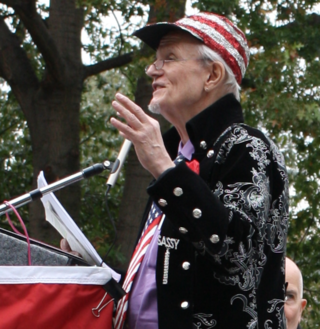
Randolfe Hayden "Randy" Wicker is an American author, activist, blogger, and archivist. Notable for his involvement in the early homophile and gay liberation movements, Wicker has documented the early years and many of the key figures of the LGBT activist communities, primarily in New York City. Since 1996, he has been active around the issue of human cloning.

Allen Young is an American journalist, author, editor and publisher who is also a social, political and environmental activist.

Martha Shelley is an American activist, writer, and poet best known for her involvement in lesbian feminist activism.
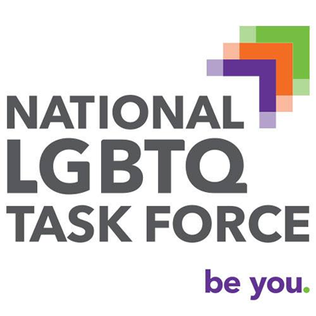
The National LGBTQ Task Force is an American social justice advocacy non-profit organizing the grassroots power of the lesbian, gay, bisexual, transgender, and queer (LGBTQ) community. Also known as The Task Force, the organization supports action and activism on behalf of LGBTQ people and advances a progressive vision of liberation. The past executive director was Rea Carey from 2008-2021 and the current executive director is Kierra Johnson, who took over the position in 2021 to become the first Black woman to head the organization.

New York City has been described as the gay capital of the world and the central node of the LGBTQ+ sociopolitical ecosystem, and is home to one of the world's largest and most prominent LGBTQ+ populations. Brian Silverman, the author of Frommer's New York City from $90 a Day, wrote the city has "one of the world's largest, loudest, and most powerful LGBT communities", and "Gay and lesbian culture is as much a part of New York's basic identity as yellow cabs, high-rise buildings, and Broadway theatre". LGBT travel guide Queer in the World states, "The fabulosity of Gay New York is unrivaled on Earth, and queer culture seeps into every corner of its five boroughs". LGBTQ advocate and entertainer Madonna stated metaphorically, "Anyways, not only is New York City the best place in the world because of the queer people here. Let me tell you something, if you can make it here, then you must be queer."
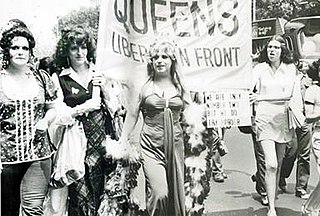
Queens Liberation Front (QLF) was a homophile group primarily focused on transvestite rights advocacy organization in New York City. QLF was formed in 1969 and active in the 1970s. They published Drag Queens: A Magazine About the Transvestite beginning in 1971. The Queens Liberation Front collaborated with a number of other LGBTQ+ activist groups, including the Gay Activists Alliance and the Street Transvestite Action Revolutionaries.
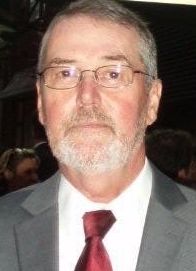
Frédéric André Sargeant is a French-American gay rights activist and a former lieutenant with the Stamford, Connecticut Police Department. He participated in each of the nights of the 1969 Stonewall riots and was one of the four co-founders of the first NYC Pride March march in Manhattan in 1970. He was vice-chairman of the Homophile Youth Movement at the time.

Come Out! was an American LGBT newspaper that ran from 1969 to 1972. It was published by the Gay Liberation Front (GLF), a gay liberation group established in New York City in 1969, immediately following the Stonewall riots. The first issue came out on November 14, 1969, it sold for 35 cents, and 50 cents for outside of New York City. Its run only lasted for eight issues. Its tagline for the first paper was: "A Newspaper By And For The Gay Community".
{{cite book}}: CS1 maint: location missing publisher (link)Beauty Records jim fouratt.
{{cite book}}: CS1 maint: others (link)